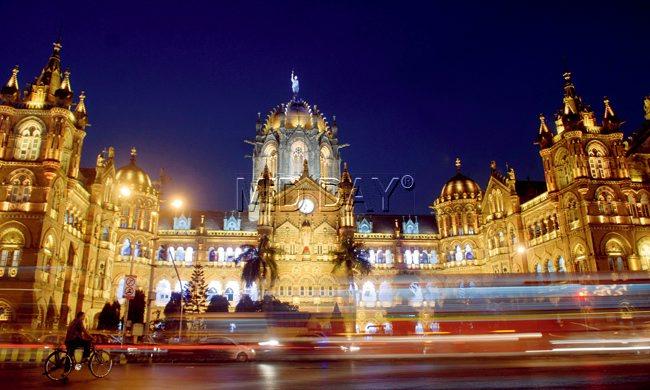As the debate rages over whether white light or yellow is best, Meher Marfatia explores how illumination first came to the city

The Chhhatrapati Shivaji Terminus in all its lit-up glory
“Who lit Bombay?” I asked from the pitch dark spot where we sat. In the shaky voice of an eight-year-old huddled with her family through nights of the 1971 Indo-Pak War. The siren would wail and lights clicked off in every home. We’d converge in the corridor of ours with a solitary candle burning. Even its subdued flicker cast not the slightest glimmer outside thanks to windows shrouded in thick brown paper. It was eerie then, exciting only now.
ADVERTISEMENT

The Chhhatrapati Shivaji Terminus in all its lit-up glory. Pic/Rane Ashish
My question hung in the blackout air. “Answer me,” I attempted saying, a la Alice, whose adventures in Wonderland I squinted to read by the flame of that same dim candle. My mother whisked away the book, bemoaning what would become of strained young eyes. Half a lifetime later, I’m still as interested to know how the City of Gold went electric after some gaslight trials.
Initiating steamer construction with the ‘Indus’ at Mazgaon docks in 1833, the master shipbuilder Ardeshir Wadia brought coal producing gas to the country. He quite literally set Bombay a shining example by gas lighting his mansion (situated on the stretch of Lalbaug today) the following February.
Next, The Times of India in August 1842 was admiring of another momentous event. A subscriber wrote of the ‘unqualified success’ of oil gaslight debuting in Framjee Cowasjee’s house: ‘As it could be insinuated that the apparatus may be procured from England and merely constructed here, I have the best authority for stating that not a single essential part of it was received from home… the whole furnace, etc. executed on the spot.’
When lighting went public, street life saw a vibrant change. Densely populated areas like Bhendi Bazaar, Esplanade and Churchgate were first to get gas-lit. Evening strolls were a novel treat for people earlier homebound by sunset. Philanthropist families like Cursetjee Manockjee’s (the Khada Parsi of the 150-year-old Byculla statue) donated fine cast iron lamps for junctions and once unlit corners to make grateful citizens feel safer by the day.
A scheme to introduce electric lighting came a cropper in 1883 after the Municipality brightened Crawford Market with the Eastern Electric Light and Power Company. The firm faced liquidation and it was back to gaslight. This continued till more funding was found for electricity from Bombay Electric Supply & Tramways (BEST, originally in England as a subsidiary of British Electric Traction Company). The Bombay Electric Licence issued in 1905 took over to beam up the city with a 4,300 kilowatts generating station at Wadi Bunder.
As the power needs of an expanding city and its tramway system mounted, a higher capacity plant opened at Kussara. The mills and the railways caused commercial and domestic consumption to surge but added reservoirs and cables of the new Tata Electric Companies helped cope with the demand.
There also rose the splendid spectacle of facade illumination. For the 1911 visit of King George V and Queen Mary, who sailed into town via the Gateway, the Taj Mahal Hotel received the royal couple with a dazzling display of lighting that grandly covered its entire facade. The exercise — costing R9,000 and including back-up generators — was laudable if you consider how soon it was executed after 1890s Chicago created a world record in a fair exhibit of facade lighting.
Wonderful how far your own feet can walk you and wake you to details of beauty. Driving along DN Road we see the magnificently lit CST station and the BMC headquarters. Actually stepping along that route one late evening with conservation architect Sanaeya Vandrewala, I’m in heritage heaven. Hidden gems on doorways and ornamented arches come amazingly alive under light shafts.
“Unlike the Gothic style of Europe which would not want their weather within, Bombay's Gothic buildings were designed to let in our gentler climate,” Sanaeya explains. Standing at the Petit Library as a cool breeze floats by its entrance, I smile in agreement.
 Subscribe today by clicking the link and stay updated with the latest news!" Click here!
Subscribe today by clicking the link and stay updated with the latest news!" Click here!







